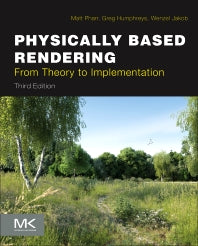Freshly Printed - allow 5 days lead
Couldn't load pickup availability
Physically Based Rendering
From Theory to Implementation
This comprehensive, updated, and expanded edition of the bestselling flagship book on physically-based rendering systems provides a complete guide to both concepts and code, including ray-tracing hair and curves primitives, numerical precision issues with ray tracing, LBVHs, realistic camera models, the measurement equation, and much more
Matt Pharr (Author), Wenzel Jakob (Author), Greg Humphreys (Author)
9780128006450, Elsevier Science
Hardback, published 21 November 2016
1266 pages
23.5 x 19 x 5.6 cm, 2.47 kg
"Physically Based Rendering is a terrific book. It covers all the marvelous math, fascinating physics, practical software engineering, and clever tricks that are necessary to write a state-of-the-art photorealistic renderer. All of these topics are dealt with in a clear and pedagogical manner without omitting the all-important practical details."
--Per Christensen, Senior Software Developer, RenderMan Products, Pixar Animation Studios
"This book has deservedly won an Academy Award. I believe it should also be nominated for a Pulitzer Prize."
--Donald Knuth
Physically Based Rendering: From Theory to Implementation, Third Edition, describes both the mathematical theory behind a modern photorealistic rendering system and its practical implementation. Through a method known as 'literate programming', the authors combine human-readable documentation and source code into a single reference that is specifically designed to aid comprehension. The result is a stunning achievement in graphics education.
Through the ideas and software in this book, users will learn to design and employ a fully-featured rendering system for creating stunning imagery. This completely updated and revised edition includes new coverage on ray-tracing hair and curves primitives, numerical precision issues with ray tracing, LBVHs, realistic camera models, the measurement equation, and much more. It is a must-have, full color resource on physically-based rendering.
1. Introduction
2. Geometry and Transformations
3. Shapes
4. Primitives and Intersection Acceleration
5. Color and Radiometry
6. Camera Models
7. Sampling Reconstruction
8. Reflection Models
9. Materials
10. Texture
11. Volume Scattering
12. Light Sources
13. Monte Carlo Integration
14. Light Transport I: Surface Reflection
15. Light Transport II: Volume Rendering
16. Light Transport III: Bidirectional Methods
17: Retrospective and the Future
Subject Areas: 3D graphics & modelling [UGK], Information theory [GPF]


